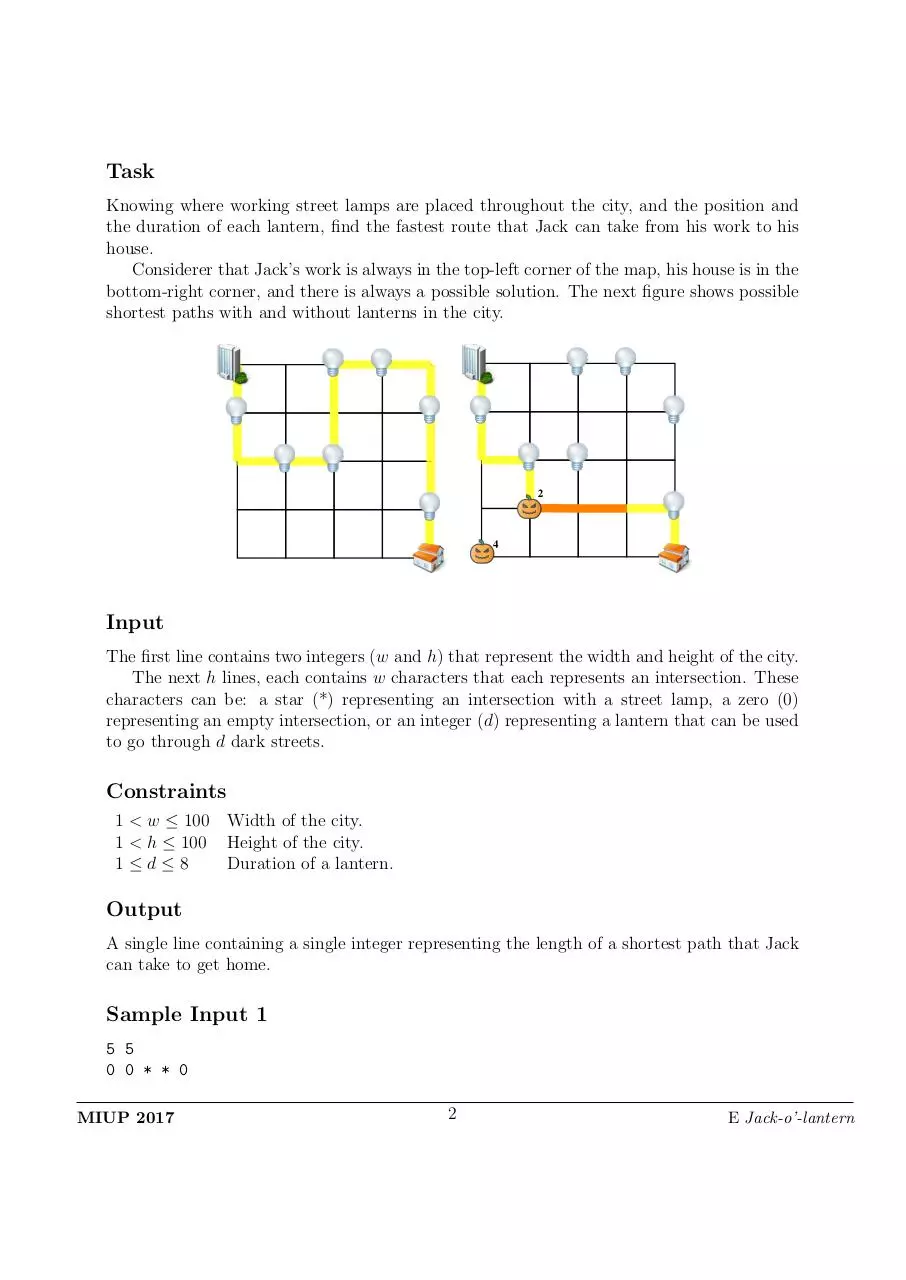jackOLantern (PDF)
File information
This PDF 1.5 document has been generated by TeX / pdfTeX-1.40.17, and has been sent on pdf-archive.com on 22/05/2018 at 17:16, from IP address 193.136.x.x.
The current document download page has been viewed 306 times.
File size: 228.99 KB (3 pages).
Privacy: public file



File preview
Problem: Jack-o’-lantern
It’s Halloween and Jack hates Halloween; the city is dark, streets are not well-lit and
strange creatures linger in every shadow. For that reason, when he goes home at night, he
never walks through streets without street lamps.
On the other hand, city planners have done a terrific job organizing the city. Every block
is a perfect square, all have the same size and all roads are laid out in a grid.
Yet, it is dark, so really dark! Street lamps are only placed at intersections and are often
non-functional making the city even scarier.
Jack wants to get home as quickly as possible, but only using well-lit streets. A street is
a piece of road that connects two intersections and Jack considers it to be well-lit if at least
one of the intersections has a working street lamp.
Luckily, as it is Halloween, lanterns are often found throughout the city, but never near
street lamps. Each lantern has a candle that Jack can use to go through a certain number
of streets. Jack can put the candle out when not needed and light it up again to go through
a dark street.
Given the bulkiness of the lanterns, Jack can only carry one with him at any given time.
He can, of course, drop it and pick another one. Lanterns are often scary, but not as scary
as a gloomy autumn night.
MIUP 2017
1
E Jack-o’-lantern
Task
Knowing where working street lamps are placed throughout the city, and the position and
the duration of each lantern, find the fastest route that Jack can take from his work to his
house.
Considerer that Jack’s work is always in the top-left corner of the map, his house is in the
bottom-right corner, and there is always a possible solution. The next figure shows possible
shortest paths with and without lanterns in the city.
Input
The first line contains two integers (w and h) that represent the width and height of the city.
The next h lines, each contains w characters that each represents an intersection. These
characters can be: a star (*) representing an intersection with a street lamp, a zero (0)
representing an empty intersection, or an integer (d) representing a lantern that can be used
to go through d dark streets.
Constraints
1 < w ≤ 100 Width of the city.
1 < h ≤ 100 Height of the city.
1≤d≤8
Duration of a lantern.
Output
A single line containing a single integer representing the length of a shortest path that Jack
can take to get home.
Sample Input 1
5 5
0 0 * * 0
MIUP 2017
2
E Jack-o’-lantern
*
0
0
0
0
*
0
0
0
*
0
0
0
0
0
0
*
0
*
0
Sample Output 1
12
Sample Input 2
5
0
*
0
0
4
5
0
0
*
2
0
*
0
*
0
0
*
0
0
0
0
0
*
0
*
0
Sample Output 2
8
MIUP 2017
3
E Jack-o’-lantern
Download jackOLantern
jackOLantern.pdf (PDF, 228.99 KB)
Download PDF
Share this file on social networks
Link to this page
Permanent link
Use the permanent link to the download page to share your document on Facebook, Twitter, LinkedIn, or directly with a contact by e-Mail, Messenger, Whatsapp, Line..
Short link
Use the short link to share your document on Twitter or by text message (SMS)
HTML Code
Copy the following HTML code to share your document on a Website or Blog
QR Code to this page

This file has been shared publicly by a user of PDF Archive.
Document ID: 0001877359.